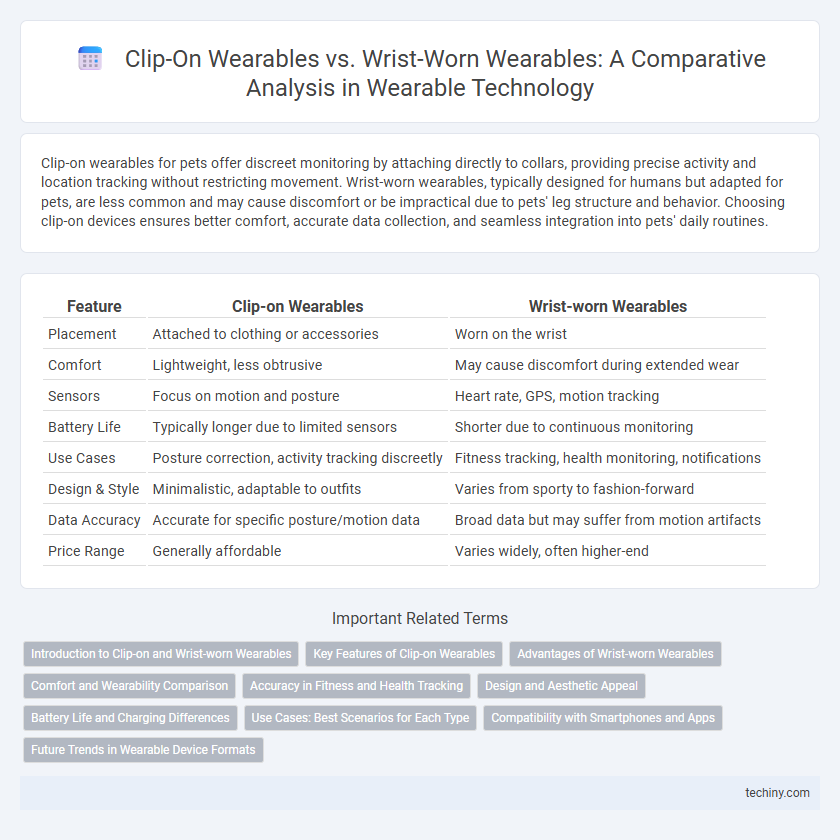Clip-on wearables for pets offer discreet monitoring by attaching directly to collars, providing precise activity and location tracking without restricting movement. Wrist-worn wearables, typically designed for humans but adapted for pets, are less common and may cause discomfort or be impractical due to pets' leg structure and behavior. Choosing clip-on devices ensures better comfort, accurate data collection, and seamless integration into pets' daily routines.
Table of Comparison
| Feature | Clip-on Wearables | Wrist-worn Wearables |
|---|---|---|
| Placement | Attached to clothing or accessories | Worn on the wrist |
| Comfort | Lightweight, less obtrusive | May cause discomfort during extended wear |
| Sensors | Focus on motion and posture | Heart rate, GPS, motion tracking |
| Battery Life | Typically longer due to limited sensors | Shorter due to continuous monitoring |
| Use Cases | Posture correction, activity tracking discreetly | Fitness tracking, health monitoring, notifications |
| Design & Style | Minimalistic, adaptable to outfits | Varies from sporty to fashion-forward |
| Data Accuracy | Accurate for specific posture/motion data | Broad data but may suffer from motion artifacts |
| Price Range | Generally affordable | Varies widely, often higher-end |
Introduction to Clip-on and Wrist-worn Wearables
Clip-on wearables attach discreetly to clothing or accessories, offering lightweight monitoring for health metrics like heart rate and activity levels without restricting movement. Wrist-worn wearables, such as smartwatches and fitness bands, provide continuous tracking with integrated displays for real-time data access and notifications. Both types leverage sensor technology, but wrist-worn devices typically offer more multifunctional features and user interaction options.
Key Features of Clip-on Wearables
Clip-on wearables offer discreet design and versatile placement on clothing, providing accurate biometric monitoring without wrist movement interference. They typically include advanced sensors for heart rate, activity tracking, and sleep analysis, optimized for continuous health data collection. Their lightweight and unobtrusive form factor enhances comfort during extended wear compared to wrist-worn alternatives.
Advantages of Wrist-worn Wearables
Wrist-worn wearables offer continuous health monitoring with advanced sensors for tracking heart rate, sleep patterns, and activity levels more accurately than clip-on devices. Their ergonomic design ensures comfort and ease of access, making them ideal for all-day wear and real-time notifications. Integration with smartphones and compatibility with various apps enhance user experience and data analysis capabilities.
Comfort and Wearability Comparison
Clip-on wearables offer enhanced comfort by minimizing skin contact and allowing flexible placement on various clothing items, reducing irritation during extended use. Wrist-worn wearables, while popular, often cause discomfort after prolonged wear due to constant pressure and limited breathability around the wrist. Choosing clip-on devices improves wearability for users seeking discreet, lightweight options without sacrificing functionality.
Accuracy in Fitness and Health Tracking
Clip-on wearables offer superior accuracy in fitness and health tracking by attaching closer to the body's core, allowing more precise measurement of metrics like heart rate and calories burned compared to wrist-worn wearables. Wrist-worn devices often suffer from motion artifacts and inconsistent contact with the skin, reducing the reliability of data such as pulse and sleep patterns. Research indicates that clip-on sensors, positioned on the waist or chest, provide more consistent readings crucial for rigorous fitness monitoring and medical applications.
Design and Aesthetic Appeal
Clip-on wearables offer discreet, versatile design options that blend seamlessly with everyday clothing, appealing to users seeking subtle technology integration. Wrist-worn wearables prioritize ergonomic form and customizable bands, enhancing comfort and style versatility for continuous wear. Both designs emphasize lightweight materials and sleek profiles to maximize aesthetic appeal without compromising functionality.
Battery Life and Charging Differences
Clip-on wearables generally offer longer battery life than wrist-worn devices due to smaller, less power-intensive displays and limited sensor use. Wrist-worn wearables often require daily or bi-daily charging because of continuous heart rate monitoring, GPS, and high-resolution touchscreens. Charging methods vary, with clip-ons typically supporting USB or magnetic charging, whereas wrist-worn devices commonly use proprietary docks or wireless charging pads.
Use Cases: Best Scenarios for Each Type
Clip-on wearables excel in scenarios requiring discreet health monitoring or specialized environmental tracking, such as tracking posture or capturing air quality data without obstructing wrist movement. Wrist-worn wearables are ideal for continuous biometric tracking and activity monitoring, including heart rate, sleep patterns, and step counting, due to their constant skin contact and convenience. Each type caters to distinct user needs, with clip-ons favored for targeted monitoring and wrist wearables preferred for comprehensive fitness and wellness tracking.
Compatibility with Smartphones and Apps
Clip-on wearables often offer broader compatibility across various smartphone brands and operating systems due to their simpler hardware and fewer software dependencies. Wrist-worn wearables typically require specific app ecosystems that may limit compatibility to particular smartphones, especially those running on the same OS. Both types benefit from Bluetooth connectivity, but wrist-worn devices generally provide more integrated app features and real-time notifications when paired with compatible smartphones.
Future Trends in Wearable Device Formats
Clip-on wearables are evolving with ultra-light sensors and flexible materials, enabling discreet health monitoring and enhanced user comfort in diverse environments. Wrist-worn devices continue to integrate advanced biometric tracking and augmented reality features, leveraging improved battery life and AI-driven analytics for personalized fitness and wellness insights. Future trends indicate a convergence of form factors, emphasizing seamless interoperability and hybrid designs that combine the convenience of clip-ons with the functionality of wrist-worn wearables.
Clip-on Wearables vs Wrist-worn Wearables Infographic

 techiny.com
techiny.com